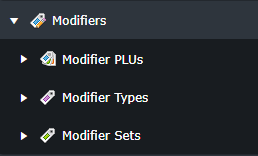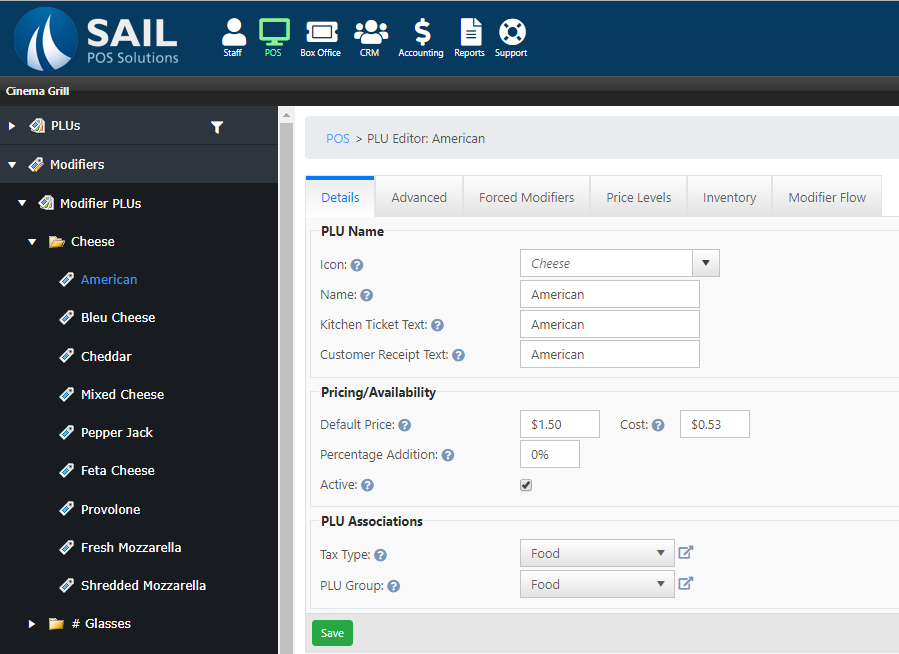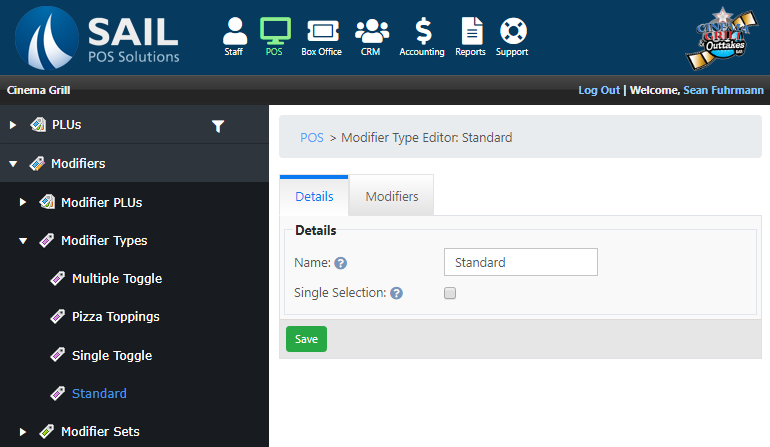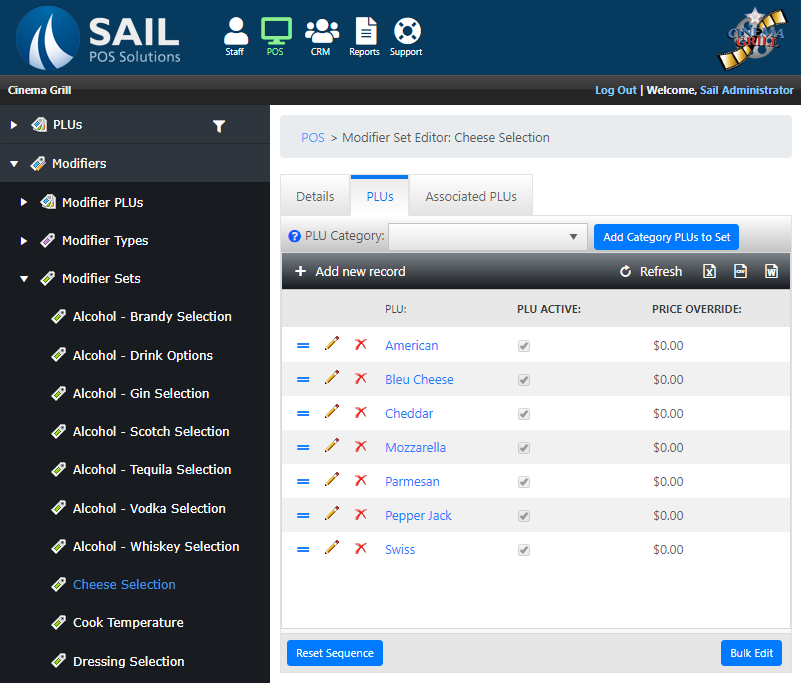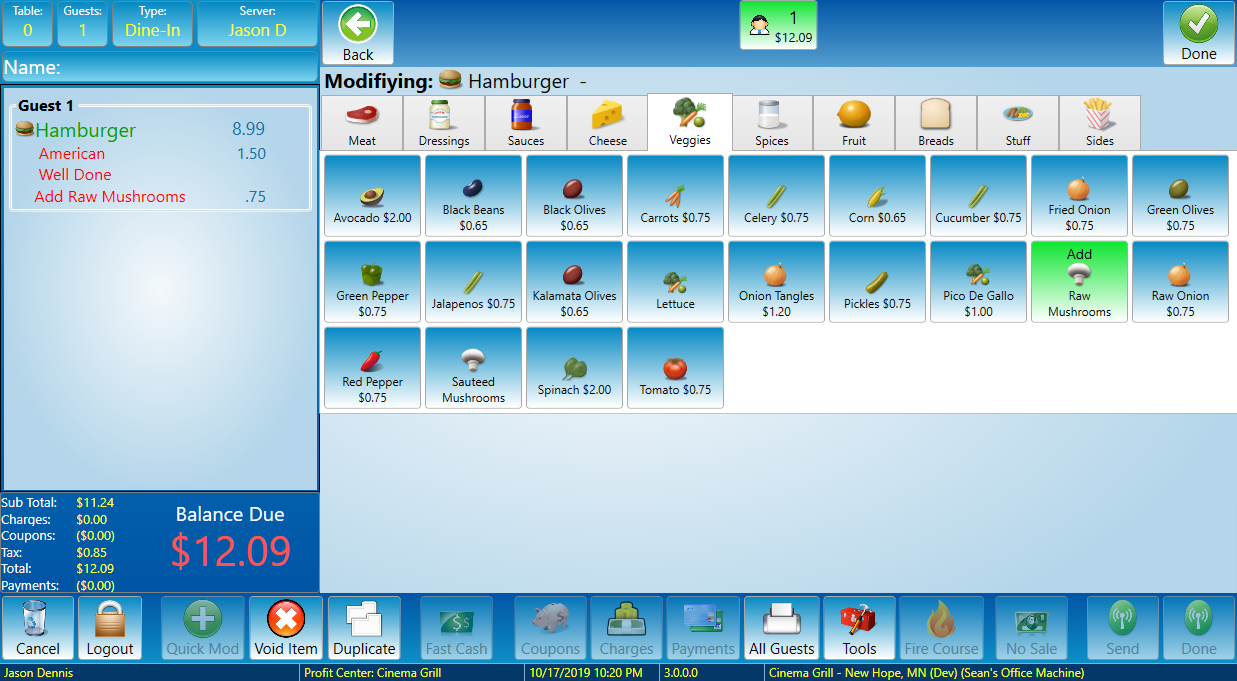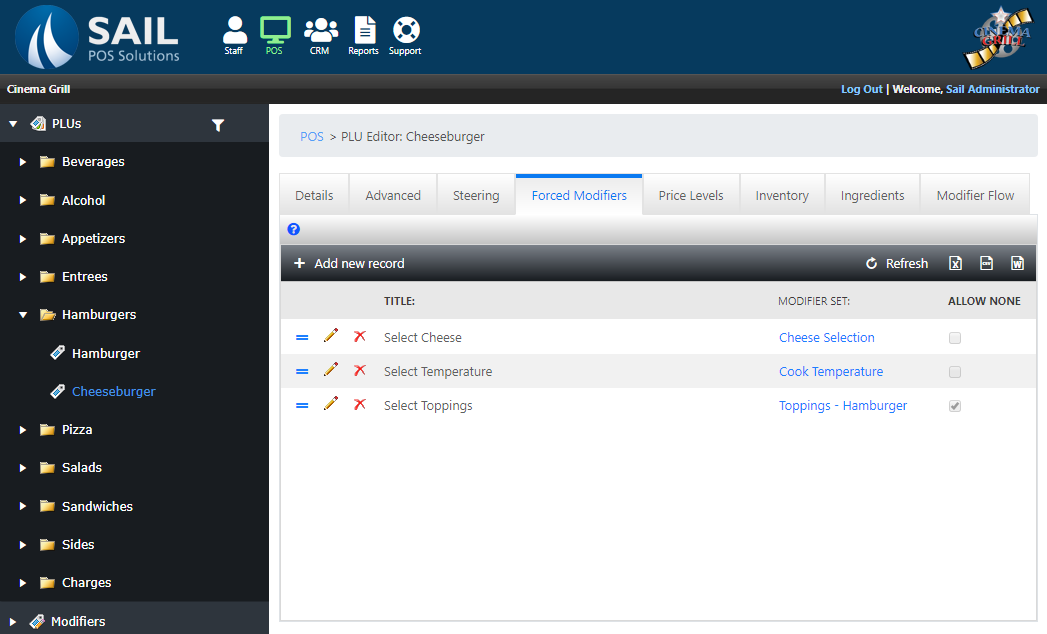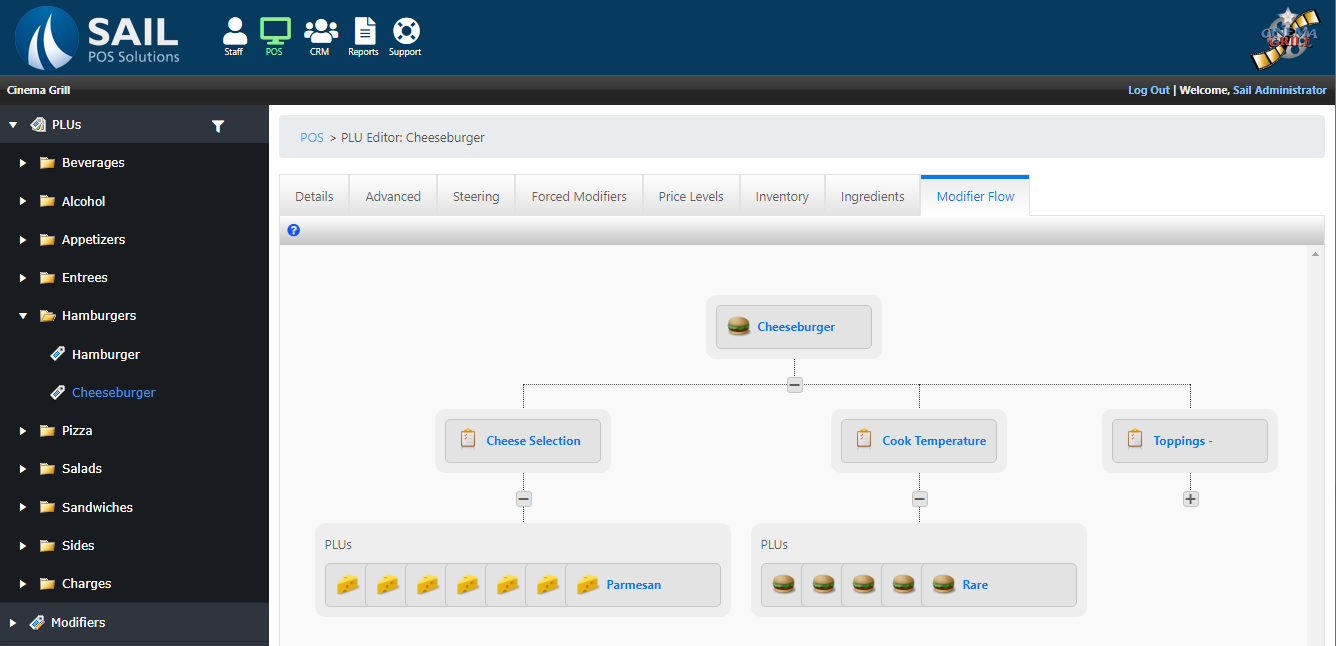Setting Up Modifiers
Modifiers are applied modifications to a PLU entry. Modifiers are very customizable in Sail POS, but initial setup can be a little daunting at first. This guide will walk you through the ins and outs of how modifiers work and how to configure them.
In the POS section of Back Office, under Modifiers, you will see the following sections:
The following sections in this document describe each of these concepts and how they relate. At a high level, here are the individual concepts summarized:
|
Modifier PLUs |
Modifier Types |
Modifier Sets |
|---|---|---|
|
PLUs that can be added to a Modifier Set |
Defines what options are shown when a Modifier Set is prompted. You can also specify a % of the PLU price to be applied. |
A collection of Modifier PLUs with an applied Modifier Type. |
|
Cheeses Meats |
Standard Pizza Toppings |
Cheese Selection Select Pizza Toppings |
Modifier PLUs
When a modifier is applied to a PLU, they are ultimately child PLUs under its parent PLU. These child PLUs used as modifiers have many of the same properties as a normal PLU, including the ability to prompt for additional modifiers (eg. a Side Salad Modifier PLU, may prompt for dressing selections). The Modifier PLUs area works almost identically to the normal PLUs area, but is designed to house PLUs that are strictly for modifications. Take the following cheeseburger rang in as an example:
American, Well Done and Raw Mushrooms are all Modifier PLUs with their individual pricing applied to each. As you can see below, the ‘American’ Modifier PLU setup looks very similar to a normal PLU setup.
Modifier Types
A Modifier Type defines how a modifier prompt reacts and the available selections given to the user. Your system comes with a typical list of Modifier Types, but you can customize or add additional types as needed
These are the 3 most common modifier types, and are included with all default installations of Sail POS:
|
Modifier Type |
Description |
|---|---|
|
Single Toggle |
Allows selecting a single modifier in the Modifier Set |
|
Multiple Toggle |
Allows toggling on or off multiple modifiers in the Modifier Set |
|
Standard |
Includes a set of options to be applied, so as Extra, No, On Side, etc. (Note: See Standard Modifiers in the Modifier Prompts section below) |
|
Pizza Toppings |
Includes pizza selections, Whole, Half 1 and Half 2 |
When defining a Modifier Type, in the Details tab you can specify a name, and specify whether or not the user is allowed select multiple options, or if only one selection is allowed.
On the Modifiers tab you define what options that can be applied. You can also drag them up and down to specify in what order they will be prompted.
In addition, you can specify a percentage that will be applied to the Modifier PLU price. For example, if you have an ‘American Cheese’ Modifier PLU that costs $1.50 - when you want to ‘Add’ that item, you want to charge the full $1.50 (100%). However, if you want to specify that they would like ‘No’ ‘American Cheese’, you wouldn’t want to charge for that, thus it is set to 0% of the price so it rings up for $0.00.
Modifier Sets
A Modifier Set houses a collection of PLUs to be prompted. It also defines how the prompt reacts by configuring its Modifier Type described above. For example, if you have a cheeseburger on your menu, you would want to prompt the user for what type of cheese they would like. A ‘Cheese Selection’ Modifier Set would be created that would specify a ‘Single Toggle’ Modifier Type, and various cheese PLUs would be assigned to the Modifier Set, such as American, Cheddar, etc. See below:
|
Field |
Description |
|---|---|
|
Name |
A short, descriptive name for this set so it can be identified when applied to a PLUs Forced Modifier list |
|
Modifier Type |
The associated Modifier Type for this set (see above) |
|
Select Category |
Typically when prompting for PLUs all associated Modifier PLUs are shown to the user on one screen. When this is checked, the system will group the PLUs by their parent PLU Category. This is typically only when there is a LONG list of Modifier PLUs to be selected and you want them organized by their category. |
|
Show In Reporting |
When checked, this set will be included in various Modifier reports. |
You specify which PLUs are included in this Modifier Set by adding them to the PLUs tab. Here you have the ability to order the prompted modifier PLUs, as well as set the order they display by dragging them.
In addition, you can specify a price override. For example, here in this ‘Cheese Selection’ Modifier Set, all cheese PLUs have a Price Override of $0 as this set will be applied to a Cheeseburger PLU where the cheese is included for free.
In addition, you can easily add all PLUs from a PLU Category by selecting it in the drop down and clicking ‘Add Category PLUs to Set’
Note: You can add both regular PLUs and Modifier PLUs to a modifier set.
Modifier Prompts
There are 2 different ways that modifiers can be applied to an item, each are described below:
Standard Modifiers
Standard modifiers are the list of modifiers that can be applied to any item, at any time. As shown below, the list of modifiers here are populated from the ‘Standard’ Modifier Set, which typically contain all of the PLUs in the ‘Standard’ Modifier PLU Category, while applying the the ‘Standard’ Modifier Type.
This is also an example of a Modifier Type that is setup to use ‘Select Category’. As you can see it groups the Modifier PLUs into tabs based on the PLUs, PLU Category.
Forced Modifiers
Forced modifiers are a list of Modifier Sets to be prompted, in a particular order, when the PLU is rang in.
Let’s continue using the cheeseburger example. When ringing in a cheeseburger you may want to prompt the user for various things. In the example below, we specify that we would like to prompt for the cheese, cook temp and any toppings they want on their burger. This is done by specifying the various Modifier Sets that contain the appropriate selections.
You can also specify whether or not the user is allowed to bypass the prompt without selecting one, or if they are forced to pick one, by toggling the Allow None flag.
There is also a visualization available to show all available prompts, with links to the Modifier Sets and their child Modifier PLUs.

